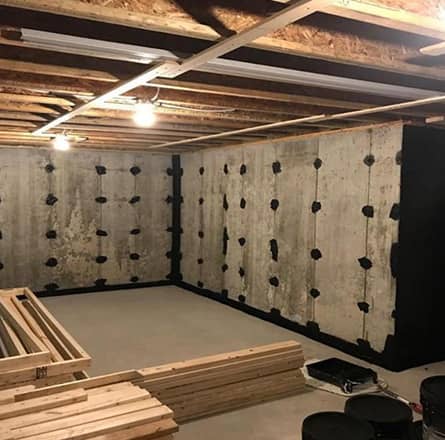Basement waterproofing paint, such as Liquid Rubber’s Foundation Sealant / Basement Coating, is a cost-efficient way to protect your home from water damage. It is a simple and easy-to-apply product that can help you avoid costly repairs and maintenance. With the right preparation and application, you can make sure that your basement is properly sealed and waterproofed.
Before you begin, it’s important to understand the basics of basement waterproofing paint, so that you can get the most out of it. This guide will provide you with the information you need to successfully use basement waterproofing paint to protect your home and keep it safe from water damage.
What is Basement Waterproofing Paint?
Basement waterproofing paint is a specialized coat of paint that protects your basement walls from water damage. Unlike regular paint, which is designed to be decorative and provide a surface seal, waterproofing paint contains special ingredients that repel water.
A properly applied coat of basement waterproofing paint can protect your walls from moisture that can cause mold and mildew. It can also help reduce the amount of time you have to wait before using your basement.
The key to a successful application is to choose the right paint for your needs and apply it correctly. The Liquid Rubber Foundation Sealant / Basement Coating, gives you a VOC-free, water-based option that has no solvents, and is a cost-effective solution for all your basement waterproofing needs.

Benefits of Using Basement Waterproofing Paint
There are many benefits of using basement waterproofing paint to protect your basement from water damage.
- Waterproofed walls are much more resilient against water damage, which can result in less expensive repairs and maintenance.
- The best basement waterproofing paint will prevent water from soaking into the surface of your walls. This can help you avoid costly repairs and maintenance, like replacing soggy drywall and repairing buckling flooring.
- Waterproofed walls will look better and last longer.
- Regular water damage can cause your walls to deteriorate more quickly. This can result in higher repair costs and may even require you to replace the walls entirely.
- Proactive basement waterproofing is the best way to prevent this and keep your home looking beautiful.
How to Prepare for Applying Basement Waterproofing Paint
Before you apply basement waterproofing paint, there are several steps you should take to prepare the surface properly.
- The first step in the process is to clean and tape your walls. You will want to remove any debris and clean the surface so that the waterproofing paint can adhere properly.
- Once your walls are clean, use a putty knife to create a smooth surface by taping off the edges. This will give you a nice, clean edge when you apply the paint.
- Next, you’ll want to fill in any cracks and holes in the wall with a filler. This will create a smooth and even surface for the waterproofing paint to adhere to.
- When you’re ready to apply the paint, be sure to choose a high-quality product that will last for years to come.
 Applying Basement Waterproofing Paint
Applying Basement Waterproofing Paint
There are a few steps to follow when applying basement waterproofing paint:
- First, you’ll want to cover the floor and equip yourself with the appropriate safety gear. You don’t want to get paint on your hands, so you’ll want to use gloves and a drop cloth, too.
- Next, load your paint roller with the appropriate amount of paint.
- You’ll want to apply a thick coat of paint to ensure a proper seal. You don’t want to apply too much paint, as this can create a sticky and difficult-to-clean surface.
- Once you’re ready to apply the paint, roll it along the wall in smooth, even strokes. Make sure to apply the paint to all areas, including corners and edges.
- Apply 2-3 heavy coats to any vertical surface for optimal results.
Tips for Applying Basement Waterproofing Paint

If you’re new to painting, you may need to practice with a smaller project before tackling your basement. It’s important to use the right tools and follow a few best practices for a successful application.
- Begin at the top of your wall, near the ceiling, and work your way down. This will help you avoid drips and messes.
- Make sure your walls are clean and free from debris before beginning.
- Apply a thick coat of waterproofing paint to ensure a proper seal.
- Keep your roller or brush wet during the application process. This will help you avoid drips and streaks.
How to Test for Basement Waterproofing Paint
If you’re not sure that your basement waterproofing paint is working properly, there is an easy way to test it: simply pour water on the walls. If the water beads up and doesn’t seem to soak into the wall, the paint is working properly. If the water soaks into the wall, you may want to consider applying a new coat of paint.
You can also take a test strip and press it against your wall to see if water beading up indicates a successful application. If water is beading up on your test strip, it’s likely the paint is working properly. If water seems to soak into the wall, you may want to apply a new coat of paint and or allow a longer curation time in between adding an extra coat.
How to Maintain Basement Waterproofing Paint
Maintaining your basement waterproofing paint is simple and easy. You can use a paintbrush and water to clean off any dust or debris that may have collected on the surface. You can also use a paint roller sleeve to gently roll the surface, which will help to remove any loose debris that may have collected on the paint.
Never use solvents or abrasive cleaners, as these will break down the paint and strip it of its waterproofing properties. You should also avoid painting over waterproofing paint. Once you’ve applied waterproofing paint, you shouldn’t have to paint over it again. This can strip the paint of its waterproofing properties.
 Need Even More Tips?
Need Even More Tips?
Liquid Rubber Foundation Sealant should be part of your basement and foundation waterproofing plan.
If you are looking for even more basement waterproofing tips, we recommend that you read our Expert’s Guide to Basement Waterproofing.
Liquid Rubber is the preferred solution for many homeowners and DIY enthusiasts, with easy-to-apply products and video tutorials that help you get the best results. Browse our online catalog to see our products, and easily order all the supplies we've featured here for your own basement waterproofing project.




